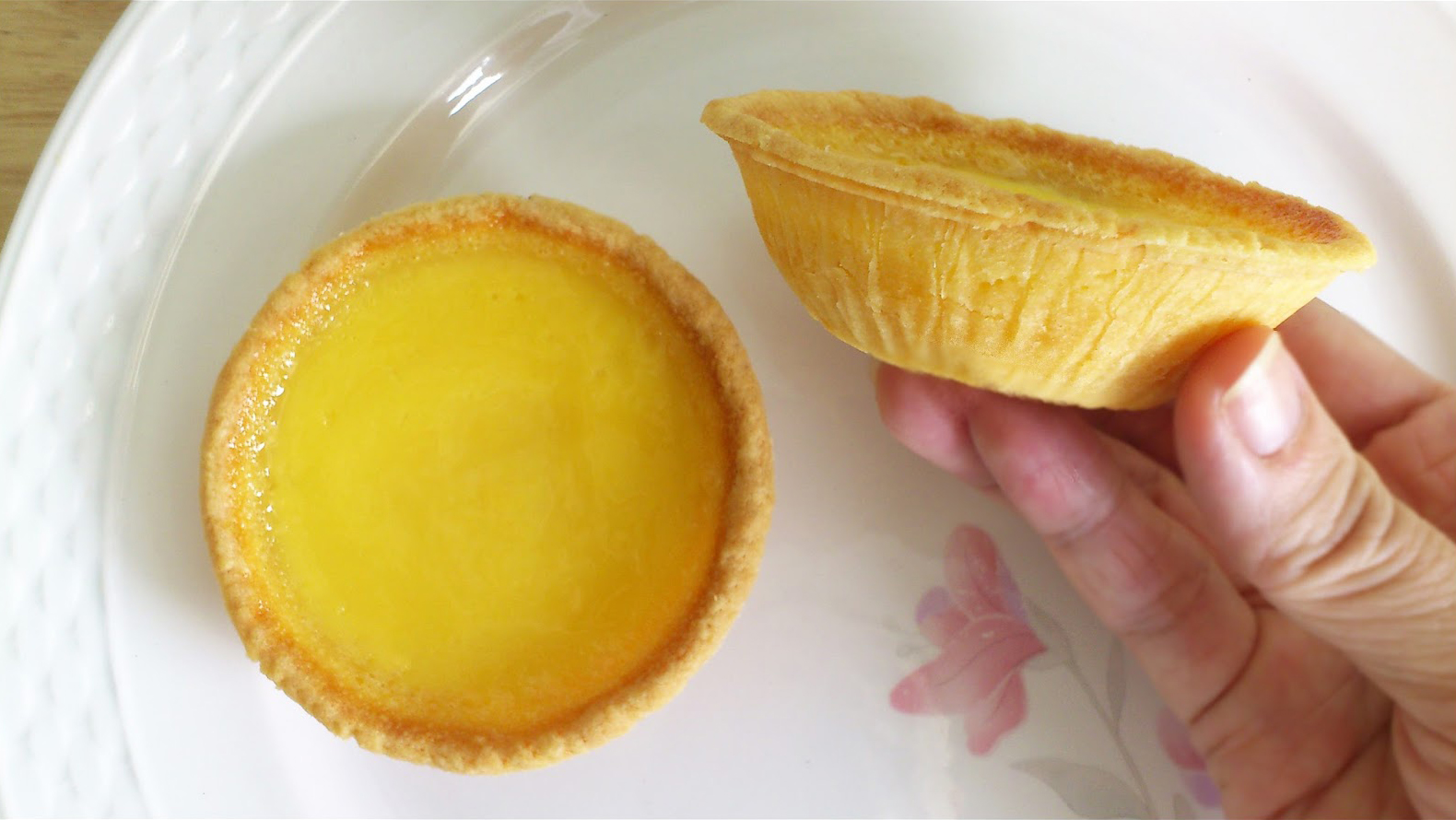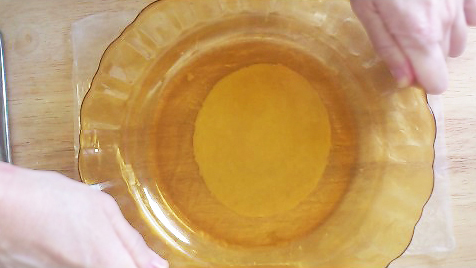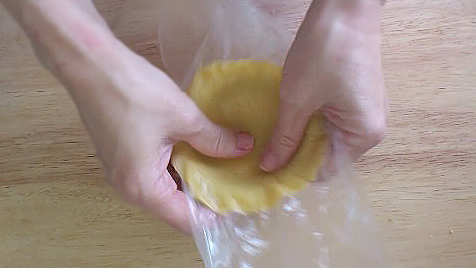Hong Kong Egg Tarts

Very few things in life are better than egg tarts fresh from the oven. The custard is soft and smooth. The tart shell is buttery and melt-in-the-mouth. Take a bite, and you’ll forget all your worries.
Tips for homemade Hong Kong Egg Tarts:
1) The best tool for flattening pastry dough isn’t a rolling pin but a plate. Just place a round blob of dough between two plastic sheets, then press it evenly with a flat-bottomed plate. Peel off the top sheet of plastic, then flip the dough into a tart mould.
2) Ease the dough into the mould, from the centre to the edges so that there’re no air pockets. Trim the excess around the rim, and you’re done. That’s all there is to it. With this method, even a novice can quickly make pastry shells that are nicely thin and even. It is, for me, much faster and easier than how professional bakers do it. They just press a lump of dough into the mould without flattening it first.
3) Sieving the custard is necessary only when you plan to use it within a couple of hours. If you have time to let it rest half a day or longer, you can skip this step. Refrigerated, the egg and milk mixture may be stored for maybe one week.

5) Don’t prick the tart shells to stop them from puffing up in the oven. If you do, they’ll leak. Instead, prebake the pastry at a low temperature of 150°C and, if there isn’t any air trapped underneath the dough, it should stay nicely flat even without pie weights. If you like, the tart shells may be chilled or frozen either before or after prebaking.
6) The shine on egg tarts comes from slightly undercooking the custard top. This is done by giving the tarts less heat from the top than the bottom. And the heat has to be quite gentle, overall, so that the eggs and milk cook into a soft and silky smooth custard.

Hong Kong Egg Tarts
Video
Ingredients
Custard filling
- 240 g eggs
- 160 g sugar
- 480 ml milk
- 1¼ tsp vanilla extract
Tart shells
- 125 g salted butter softened
- 60 g icing sugar sifted
- 15 g egg white
- 15 g egg yolk
- 1 tsp vanilla extract
- 210 g plain flour
Instructions
- To make tart filling, whisk sugar with eggs till melted. Add milk and vanilla extract. Whisk till evenly mixed. Sieve to remove bubbles, into a container that pours without dripping.240 g eggs, 160 g sugar, 480 ml milk, 1¼ tsp vanilla extract
- To make tart dough, mix butter and icing sugar till smooth. Add egg white, yolk and vanilla extract. Mix till well combined and smooth. Add flour. Mix thoroughly. If dough is sticky, sprinkle with flour 1 tsp at a time and mix through. If dough is dry and crumbly, sprinkle with water 1 tsp at a time and mix through.Place dough in freezer till just firm, spread out to cool down faster. This should take 10 minutes or so. When lining tart moulds, remove dough from freezer ¼ portion at a time.125 g salted butter, 60 g icing sugar, 15 g egg white, 15 g egg yolk, 1 tsp vanilla extract, 210 g plain flour
- To line tart moulds, smooth 2 plastic sheets so that there are no folds. Roll 30 g dough into a ball. Place ball between plastic sheets. Press evenly with flat-bottomed plate to form a circle 2 mm thick and 10 cm wide, checking thickness and evenness by touching dough with palm. Remove top plastic sheet. Place 8 x 2.5 cm tart mould on dough, rim side down. Flip mould, along with dough and remaining plastic sheet, to face upward. Press dough into mould, from centre to rim. Remove plastic sheet. Trim excess dough around edges. Run fingers round tart mould, gently pressing to even out thickness and remove air pockets if necessary. Trim again if there's excess dough.
- To bake tart shells, preheat oven to 150°C. Place shells on baking tray. Bake 15 minutes in middle of oven. Increase temperature to 180°C. Continue baking till slightly brown, another 5 minutes or so. Remove from oven. Leave on wire rack to cool down completely.
- To bake tarts, preheat oven to 165°C. If you want to line your baking tray with foil, it should be shiny side down. Pour custard into shells, to 2 mm from rim. Bake 15 minutes in bottom of oven. Reduce temperature to 150°C. Move tray to middle of oven. Top up filling to make up for evaporation. Bake till custard is just slightly wobbly in the middle when shaken, another 15 minutes or so. If custard puffs up during last few minutes but is still too watery in the middle, remove tarts from oven to cool down till custard subsides, then continue baking. Watch custard closely towards the end to make sure it doesn't overcook.
- Serve tarts hot or warm. Refrigerate leftovers. To reheat, remove tarts from moulds. Reheat in oven at 120°C using bottom heat only for 10 minutes or so.